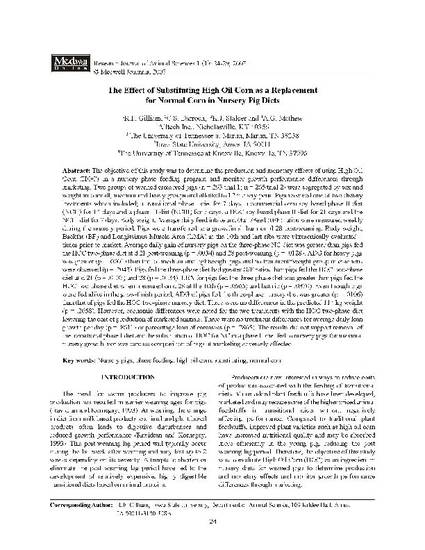
The objective of this study was to determine the production and monetary effects of using High Oil Corn (HOC) in a nursery phase feeding program and monitor growth performance differences through marketing. Two groups of weaned crossbred pigs (n = 293 trial 1; n = 265 trial 2) were segregated by sex and weight into small, medium and heavy groups and allotted to 12 nursery pens. Pigs received one of two dietary treatments which included; a transitional phase I diet for 7 days; a commercial corn soy based phase II diet (NCII) for 14 days and a phase III diet (NCIII) for 7 days; a HOC soy based phase II diet for 21 days and the NCIII diet for 7 days. Body weight, Average daily feed intake and Gain/Feed (G/F) ratios were measured weekly during the nursery period. Pigs were transferred to a grow/finish barn on d 28 post-weaning. Body weight, Backfat (BF) and Longissimus Muscle Area (LMA) at the 10th and last ribs were ultrasonically evaluated 4 times prior to market. Average daily gain of nursery pigs on the three-phase NC diet was greater than pigs fed the HOC two-phase diet at d 21 post-weaning (p = .0034) and 28 post-weaning (p = .0128). ADG for heavy pigs was greater (p = .0001) than that of medium and lightweight pigs and no treatment�weight group interactions were observed (p = .2043). Pigs fed the three-phase diet had greater G/F ratios than pigs fed the HOC two-phase diet at d 21 (p = .0137) and 28 (p = .0134). LEA for pigs fed the three-phase diet was greater than pigs fed the HOC two-phase diet when measured on d 28 at the 10th (p = .0565) and last rib (p = .0370). Even though pigs were fed alike in the grow-finish period, ADG of pigs fed the three-phase nursery diet was greater (p = .0106) than that of pigs fed the HOC two-phase nursery diet. There were no differences in the predicted 114 kg weight (p = .2658). However, economic differences were noted for the two treatments with the HOC two-phase diet lowering the cost of production of marketed animals. There were no treatment differences for average daily lean growth per day (p = .8611) or percentage lean of carcasses (p = .2865). The results did not support removal of the transitional phase I diet and the substitution of HOC for NC in a phase II diet fed to nursery pigs for maximal nursery growth, nor was carcass composition of pigs at marketing adversely affected.
Available at: http://works.bepress.com/kenneth_stalder/190/

This article is published as Gilliam, R. F., C. S. Darroch, K. J. Stalder, and A. G. Mathew. 2007. The effect of substituting high oil corn as a replacement for normal corn in nursery pig diets. Res. J. Anim. Sci. 1:24-29. Posted with permission.